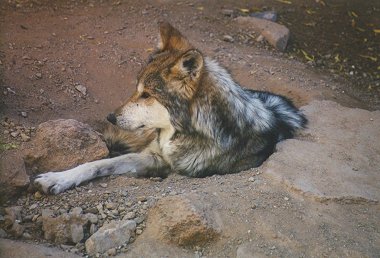| |
Mexican Wolf
 |
 |
 |
|
|
| Until recent times, the Mexican Wolf
ranged the Sonoran and Chihuahuan deserts from central Mexico to western
Texas, southern New Mexico and central Arizona. Starting in 1914,
Congress appropriated $115,000 to hire hundreds of federal hunters whose
primary job was killing every wolf, mountain lion, coyote, grizzly and
other major predator in the nation. These efforts were all to
successful, and by the 1950s, the Mexican Wolf had become extinct in the
wild. In 1976, the Mexican Gray Wolf was declared an endangered species
and has remained so ever since. Less than 200 Mexican Wolves now survive
in zoos and museums due to successful captive breeding programs. In
March 1997, the U.S. Secretary of the Interior authorized the U.S. Fish
and Wildlife Service to begin reintroducing Mexican Wolves into the Blue
Range area of Arizona. The overall objective of this program is to
reestablish 100 Mexican Wolves in the Apache and Gila National Forests
of of Arizona and New Mexico by 2005. |
| |
 |
Natural
History |
 |
|
The Mexican Wolf is the rarest,
southernmost and most genetically distinct sub-species
 of
the Gray Wolf in North America. It is also one of the smallest
sub-species, reaching an overall length no greater than 4.5 feet and a
height maximum of about 32 inches. of
the Gray Wolf in North America. It is also one of the smallest
sub-species, reaching an overall length no greater than 4.5 feet and a
height maximum of about 32 inches.
|
It is unlikely you'll ever see a
Mexican Wolf in the wild. This photo was taken at the Arizona -
Sonora Desert Museum. |
The wolf looks much like a German Shepherd, but it has
a broader skull and longer ears. It is also more bushy-tailed,
long-nosed and long-legged. The Mexican Wolf has a tendency to look lean
and rangy somewhat like a coyote, but it is larger and carries its tail
high rather than low. Wolves usually travel in packs and establish
territories ranging from 30 to more than 500 square miles. They define
their ranges with scent markings and vocalizations such as growls, barks
and howls. Wolves eat a wide variety of food, including small animals
like mice and squirrels, large animals like deer and moose and
sometimes, carrion and plant material. Animals killed are usually young,
old, or otherwise impaired and weaker than others. Only the alpha pair
in each pack breed each year. This occurs between January (at low
latitudes) and April (at higher latitudes). A litter of 6 to 7 pups is
born blind after a gestation period of about 63 days. The pups are
reared in a den composed of a natural hole or burrow. All members of the
pack care for the pups, who are fed regurgitated meat after hunts. Pups
are weaned at about the fifth week and approach adult size by early
winter. By autumn, because pups are now capable of traveling with the
adults, the pack hunts as a unit throughout its territory. Juveniles
remain with the pack until they reach sexual maturity at about two
years, after which they may leave to search for a mate and establish new
territories, or remain as helpers. |
Back to Flora & Fauna |
|

